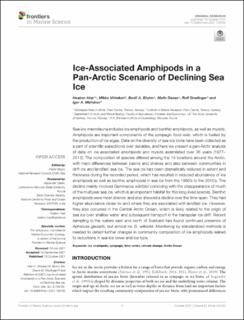| dc.contributor.author | Hop, Haakon | |
| dc.contributor.author | Vihtakari, Mikko | |
| dc.contributor.author | Bluhm, Bodil | |
| dc.contributor.author | Daase, Malin | |
| dc.contributor.author | Gradinger, Rolf | |
| dc.contributor.author | Melnikov, Igor A. | |
| dc.date.accessioned | 2021-11-17T08:12:13Z | |
| dc.date.available | 2021-11-17T08:12:13Z | |
| dc.date.created | 2021-11-12T19:19:26Z | |
| dc.date.issued | 2021 | |
| dc.identifier.citation | Frontiers in Marine Science. 2021, 8 1-16. | en_US |
| dc.identifier.issn | 2296-7745 | |
| dc.identifier.uri | https://hdl.handle.net/11250/2829976 | |
| dc.description.abstract | Sea-ice macrofauna includes ice amphipods and benthic amphipods, as well as mysids. Amphipods are important components of the sympagic food web, which is fuelled by the production of ice algae. Data on the diversity of sea-ice biota have been collected as a part of scientific expeditions over decades, and here we present a pan-Arctic analysis of data on ice-associated amphipods and mysids assimilated over 35 years (1977–2012). The composition of species differed among the 13 locations around the Arctic, with main differences between basins and shelves and also between communities in drift ice and landfast sea ice. The sea ice has been dramatically reduced in extent and thickness during the recorded period, which has resulted in reduced abundance of ice amphipods as well as benthic amphipods in sea ice from the 1980’s to the 2010’s. The decline mainly involved Gammarus wilkitzkii coinciding with the disappearance of much of the multiyear sea ice, which is an important habitat for this long-lived species. Benthic amphipods were most diverse, and also showed a decline over the time-span. They had higher abundance closer to land where they are associated with landfast ice. However, they also occurred in the Central Arctic Ocean, which is likely related to the origin of sea ice over shallow water and subsequent transport in the transpolar ice drift. Recent sampling in the waters east and north of Svalbard has found continued presence of Apherusa glacialis, but almost no G. wilkitzkii. Monitoring by standardized methods is needed to detect further changes in community composition of ice amphipods related to reductions in sea-ice cover and ice type. | en_US |
| dc.language.iso | eng | en_US |
| dc.title | Ice-Associated Amphipods in a Pan-Arctic Scenario of Declining Sea Ice | en_US |
| dc.type | Peer reviewed | en_US |
| dc.type | Journal article | en_US |
| dc.description.version | publishedVersion | en_US |
| dc.source.pagenumber | 1-16 | en_US |
| dc.source.volume | 8 | en_US |
| dc.source.journal | Frontiers in Marine Science | en_US |
| dc.identifier.doi | 10.3389/fmars.2021.743152 | |
| dc.identifier.cristin | 1954224 | |
| dc.relation.project | Norges forskningsråd: 268286 | en_US |
| dc.relation.project | Norges forskningsråd: 244646 | en_US |
| cristin.ispublished | true | |
| cristin.fulltext | original | |
| cristin.qualitycode | 1 | |
